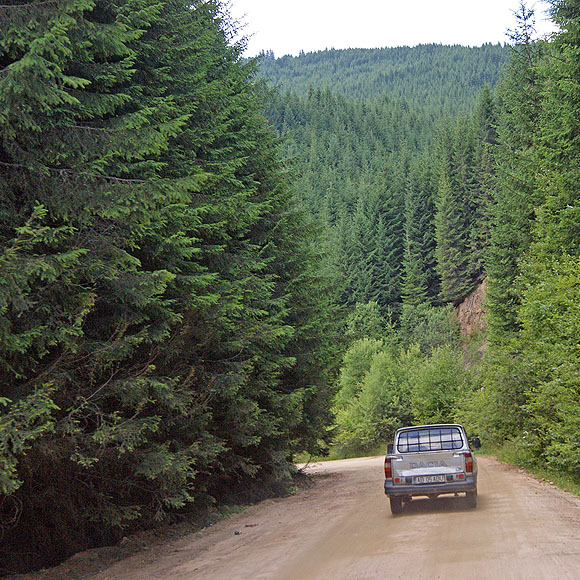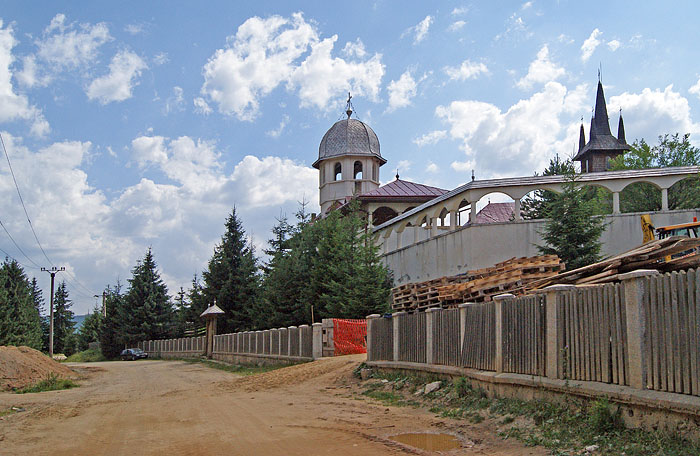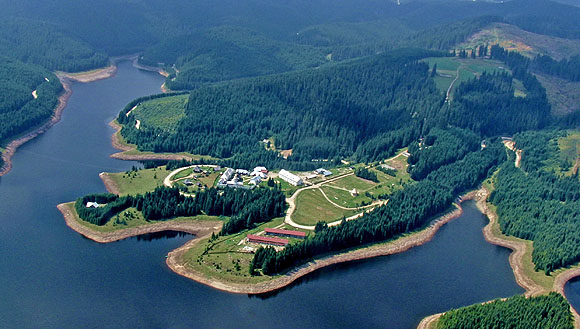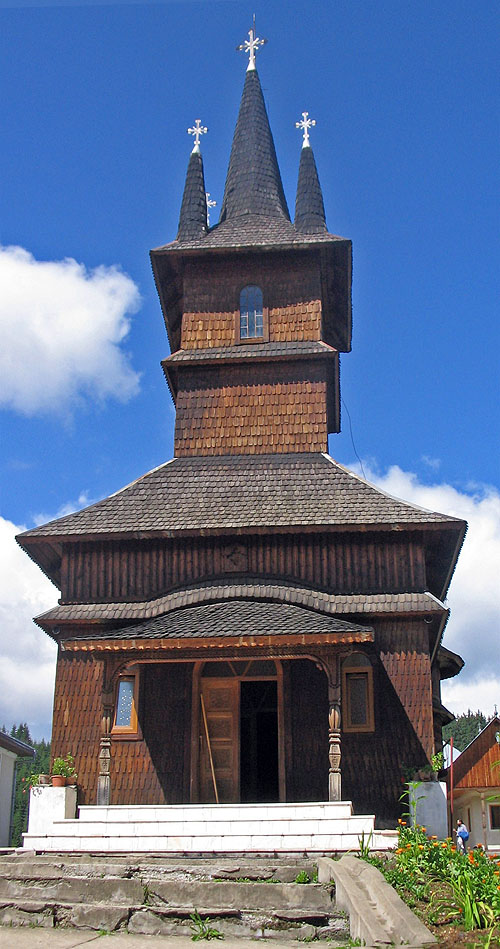The road to heaven
17 June 2018Steam from warm mamaliga rises up and fogs my glasses as my mind slowly clears. “Why am I having corn mush for breakfast?” I ask myself. The day before slowly comes into focus, not a dream after all I guess. The pine plank of a bench provides me uncomfortable support but after the ride yesterday I’ll take anything. Gazing out the frosted window I find nearly half a metre of snow, quite a difference from what was in Bucharest when I left.
“So, how ‘bout a cup of coffee?” cries out an accent I hadn’t heard in quite a while. An American accent. An American accent coming from a black bearded Orthodox Monk?
No, I must still be dreaming.
But, never being one to turn down a cup of coffee I agreed with a nod. After the first few sips I realised everything had happened. I am here.
“Where is here again?”

The day had begun like any other Monday: slow. But it would turn out to be one where fate would guide me, and God would literally tell me where to go. Days like this don’t come around so often; it’s best to pay attention when they do.
In preparation for my next project I decided to get out of town for a couple of days. Odd how one’s thought processes are better when not surrounded by flashing green, orange and red, endless beeping, television, hounding hookers, and smoggy air.
Well, we know what it’s like to live in Bucharest. It’s a fine city with plenty of charm, but we all need a break at times. This was my time. I was off to Sinaia to take up the offer of a monk I had first met two years earlier. He invited me to stay at their monastery whenever I had the chance. This was my first chance and decided some clean air, mountains and positive energy wouldn’t be so bad.
Arriving right on schedule at 2 in the afternoon, I entered the church and spoke with Abbot Melkesedek. I told him my situation and asked if I may stay a few days there. Still under construction, Monastery Cota 1000, on the road from Sinaia to Targoviste, is nestled perfectly in the mountains; it would surely provide a great place to relax. However, the guest quarters were not heated yet. Still a work in progress. But, being sympathetic and wanting to help, Father M offered to take me to another monastery; one where I find peace, quiet, and a fellow American to talk to. Before I had a chance to ask “Where?” or “Are you sure it’s no trouble?” my bags were in the four by four. Nothing is trouble for those living in a monastery. Romanian hospitality combined with monastic vows to help and serve? They could teach a course at Cornell!
Driving north, he made arrangements on his mobile for our accommodation. He was far removed from the stereotype of a monk: 4×4, hands free mobile, negotiating down car prices for other monasteries – quite the man. Driving for well over an hour and I’m starting to feel a bit guilty, but as we approach Brasov he assures me it’s not much further. But where we were heading was anything but close. I realised that as we approached Sibiu, which was two hours west of Brasov and about five years west of Bucharest.
Guilt continued to mount as we drove to the small town of Sebes and turned left. We were heading directly up into the Fagaras Mountains and yet there was no road to get there.

Winter, night, snow, and what could hardly be considered a road lay ahead as we made the final leg of our trip. The marker on the side of the road indicated that there were 35 kilometres to Oasa Monastery, our destination. If you have lived in Romania for a while you know that distance has absolutely nothing to do with time. (In fact, not much has to do with time, but I digress.) So these 35 kilometres would take you about 30 minutes on a decent Romanian road, about 20 minutes in Western Europe, and the way I used to drive about 12. So, you can imagine how bad this road had to be when I tell you it took over two hours. I always knew the road to heaven was a difficult one, but this was just ridiculous. This uphill path was for the truly determined. The feeling of guilt grew with each bump and pothole.
“What have I done to deserve this?” I thought.
This monk was not interested in money. I tried to make a donation, but he insistently refused saying it was not him I owed. Damn, that’s hard to hear. Needless to say even after we reached the peak, I had a lot more climbing to do.
After nine hours on the road and up the mountain path we finally reached Oasa at 11.45. Just enough time for Father M to eat something before midnight – one of many traditions of monastic life that I would soon learn about. A ciorba and cup of tea later I went to bed hardly believing the day I had just had. You can call it fate, or destiny or just coincidence but never have I been given such a clear sign. It was pretty easy to understand how the next morning would have one questioning the events of the prior day. Having mamaliga for breakfast at nearly 2,000 metres, in Romania’s highest monastery, while talking with an American monk over a cup of coffee: this was certainly no dream.
Born Catholic in New Orleans with the name of Steven, this 48-year-old former accountant gave up the world for monastic life eight years ago. Wisps of steam rose from his cup mystically dancing past his beard and glasses as he told me his story. Really quite a story; his conversion, his vow to be a monk, his travels to Mount Athos in Greece, and being told by different abbots and monks that Oasa, Romania was the place for him. More than four years ago he arrived in Romania, and has been down the mountain nine times since.
![Sava-VID[1]](https://pemptousia.com/files/2015/06/Sava-VID1.jpg)
Fr. Sava
A singer, teacher and mentor to some of the younger monks, Father Sava was my guide this week as well. We laughed at shared experiences of white water rafting in North Carolina. Discussing secret dreams of where we each want to end up, we listened. And contemplating religion and spirituality we agreed to disagree. I am not Orthodox and don’t plan to become Orthodox but I have deep respect for many of the world’s religions and few times in a lifetime does one have the opportunity to discuss the topic with a monk. Being Orthodox, however, Father Sava did not share my respect for other religions, and followed The Way – any other path was the wrong path. One must understand and respect that when one gives up their life for God, they are pretty much set in their ways. We maintained our civility and continued to have further and deeper discussions.
It was Socrates who said that the best method of learning was a teacher and single student perched on a log questioning and answering. The snow-covered paths with overhanging pines were our classroom, an amazing setting to learn as we walked around the grounds. The mythical master/student relationship. The ritual of a young man seeking advice from an elder.
In addition to our talks, Father Sava showed me how to heat my wood burning soba, and told me the schedule for church service. I figured that telling him the last time I was awake at 6.00 am I was coming out of Kristal Club was not a good idea. Following his example, I simply set my alarm and went to bed at eight: quite a change from city life.
I planned to stay at Oasa for about three nights. (Funny how plans don’t always work out the way you thought. I have two favorite quotes about planning: First, “If you fail to plan, you plan to fail” and “A plan is just a list of things that don’t happen.” My philosophy falls somewhere between the two.) Due to Father M’s departure, I had two remaining options to get down the mountain: by foot, or wait until Sunday. Calculating the weather conditions and my recent exercise routine, I opted for the latter. Trekking nearly 20 miles through the snow-covered paths and wolf infested forests during a full moon, or waiting and reading Father Sava’s homework (biblical proof that Darwin was wrong). It was a decision that was briefly contemplated, but better to have life and limbs than not have them. So, for another few nights I would be a guest at what is certainly one of the most enchanting monasteries in Romania.

Located south of Sebes in Transylvania at an altitude of almost 2,000 metres, Oasa Monestary was built in the late 1980s. It is neither as historic as those in Targoviste, nor as beautifully painted as the more famous monasteries in northeastern Romania, but still, Oasa is different. I am not a monastery pilgrim, but living in a country with nearly 600, one is bound to stumble onto a monastery at some point in Romania; which has the highest ratio of people living in monasteries in Europe. Originally built for women, Oasa is similar to many of its counterparts across the country; small wooden church with stone foundation surrounded by a bell tower, dining quarters, living quarters. Its enchantment comes from its location and its inhabitants. Thousands of snow-covered pine trees blanketed the surrounding hills and mountains. This fairly tale, Christmas card land with virgin snows, fresh water spring and mountain lake was so perfect that it hardly seems real as I write this.
Living in Oasa are about 20 male brothers and fathers ranging in age from 20 to 70. The oldest was forced out of another monastery 40 years ago by the communist law stating that all men under the age of 50 had to leave monastic life. He married, had children and grandchildren, but was invited back to spend the rest of his days at Oasa having took his monastic vows years earlier and, therefore keeping his 40-year-old commitment.
Most others living in Oasa were quite young for monks, and very highly educated; some were theology, philosophy and maths scholars. They had a contagious youthful joy that spread to all who visited. During the four daily church services, however, they were as serious and focused as any monk you would imagine. With the first service of the day at 3.00 in the morning, their discipline was far removed from most men. One of my highlights was being asked to ring the bells for the call to prayer. High in the bell tower with a priceless view were four bells of various sizes and tones. Hearing the bells from your room is one thing, but being inside the tower pulling the ropes can be deafening. With chaotic yet beautiful rhythm we rang the mighty bells like young children waking their parents on Christmas morning.
Aside from the monks, Oasa and surroundings were also home to a handful of construction workers and one professor. Father Sava and I were invited to join this professor to discuss several topics ranging from the apocalypse to America’s role in the modern world. He lived in a tiny room with an inspiring view of the lake, formerly used by the department of forestry. Most of his time was dedicated to translation of the book of Isaiah from ancient Greek to Romanian. Quietly enjoying his life of solitude, he planned to stay there for at least ten years.
 My small guest room at Oasa had everything I could ask for including a bed, desk and heat. I was set to develop my plans free of the distractions of the city. By the third day I was comfortably free from my chains of keys, wallet, mobile phone and watch. Without them I was oddly off balance initially, but soon learned to treasure the freedom that only empty pockets and a blank agenda can provide. Days at Oasa for me usually had the following programme: wake, church, read, write, walk, eat, write, read, church, eat, read, write, read, sleep. That may sound easy, but hermitage life is far from a walk in the park. With no money and no distractions one is left to turn to the only person around – yourself. You are left to face your strengths, weaknesses, fears, hopes, and loves. It is a delightfully joyful yet challenging experience. Give it a try.
My small guest room at Oasa had everything I could ask for including a bed, desk and heat. I was set to develop my plans free of the distractions of the city. By the third day I was comfortably free from my chains of keys, wallet, mobile phone and watch. Without them I was oddly off balance initially, but soon learned to treasure the freedom that only empty pockets and a blank agenda can provide. Days at Oasa for me usually had the following programme: wake, church, read, write, walk, eat, write, read, church, eat, read, write, read, sleep. That may sound easy, but hermitage life is far from a walk in the park. With no money and no distractions one is left to turn to the only person around – yourself. You are left to face your strengths, weaknesses, fears, hopes, and loves. It is a delightfully joyful yet challenging experience. Give it a try.
Our meals at the monastery consisted of, not surprisingly, simple natural foods: homemade cheese, milk, yogurt, mamaliga, bean soup, rice, and maybe an old apple. Not a culinary delight, but that’s not really the reason one goes to a monastery.
Of the several lessons and traditions learned about the Orthodox faith, I found most moving the tradition of liturgy and the music. For over 1,700 years the liturgy service has been the same throughout the Orthodox world. And the songs sung today have changed only by the voices carrying the notes. I knew little about the faith in hindsight. But after much discussion, reading, and attendance at church I walked away with a greater understanding of the oldest of Christian faiths. I literally went to more church that week, than the prior four years combined.
So am I better for it? Undoubtedly. I find myself more focused, organised, cheerful and energetic. And I have a new appreciation for a plate of steaming mamaliga in the morning.
Source: vivid.ro






